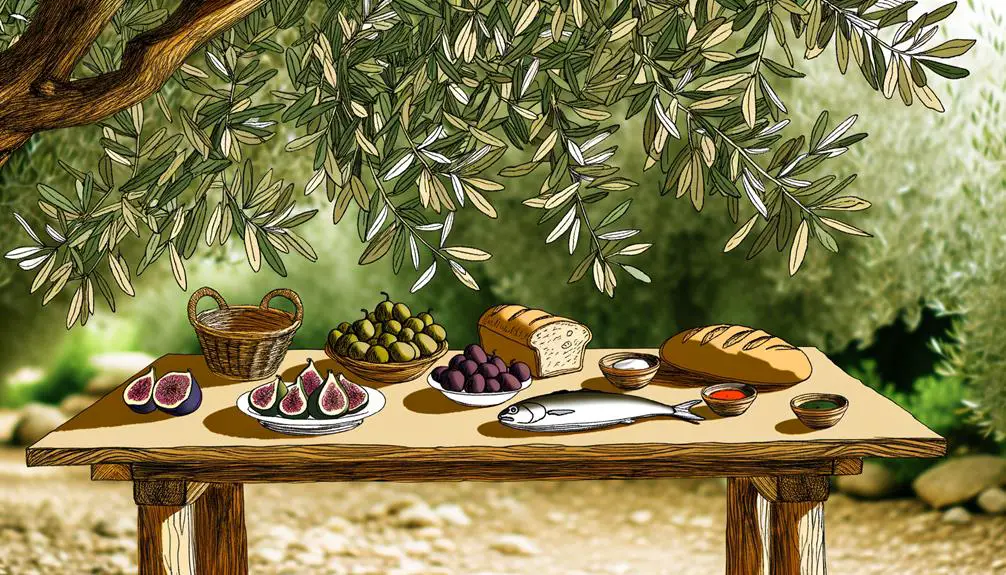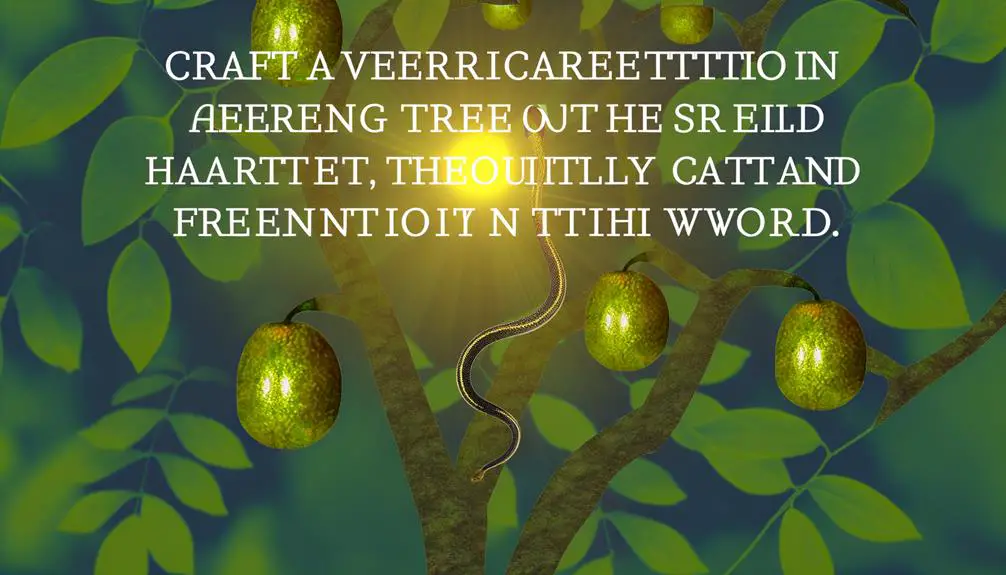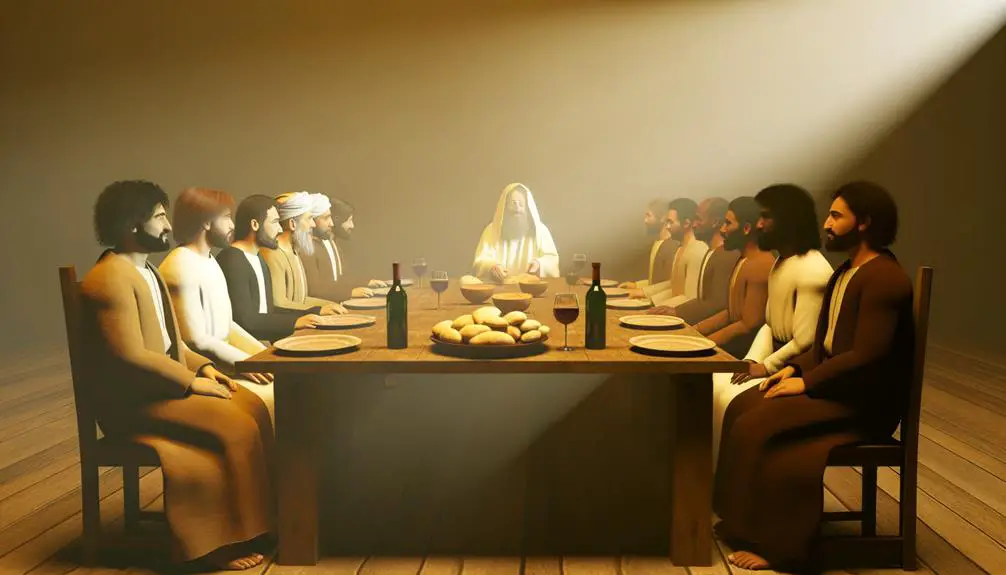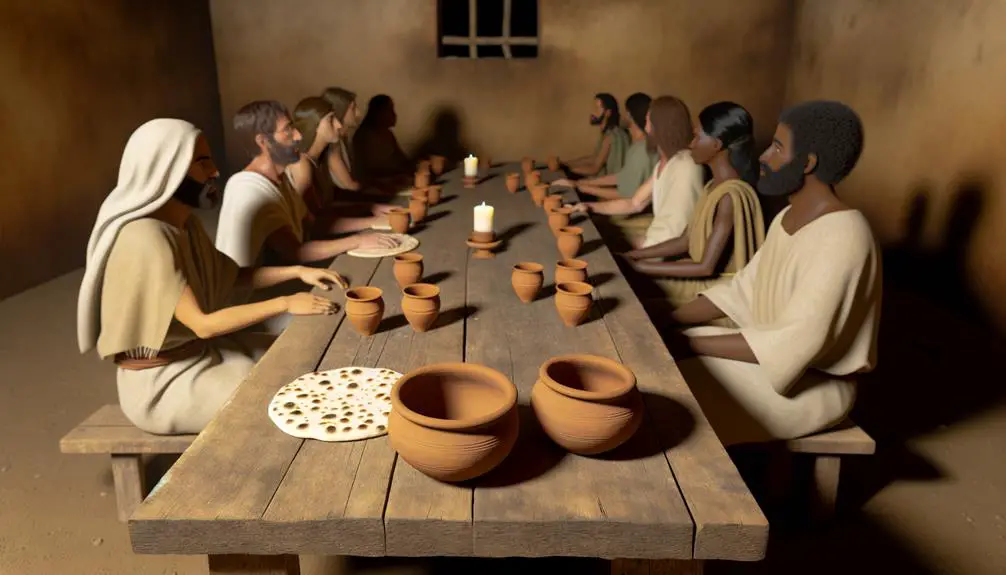Discover how eating in the Bible reveals profound spiritual truths and divine mysteries, urging a deeper exploration of its sacred texts.

Eat in the Bible
In the Bible, eating is laden with deep symbolic significance that transcends mere sustenance. You'll encounter the pivotal moment of Adam and Eve's consumption of the forbidden fruit, symbolizing the awakening to moral discernment. Similarly, the divine provision of manna to the Israelites in the desert, highlights themes of reliance and trust in God. The Passover meal and the Last Supper embody covenantal promises and redemption, through their ritualistic elements. Additionally, Jesus feeding the multitudes and the transformation of dietary laws under Peter's vision emphasize inclusivity and spiritual nourishment. Exploring these narratives uncovers layers of theological insight.
Key Takeaways
- Eating the forbidden fruit in Eden symbolizes the awakening of moral and ethical discernment in humanity.
- Manna from heaven represents God's provision and the necessity of reliance on divine support for the Israelites.
- The Passover meal commemorates Israel's deliverance from Egypt, emphasizing the importance of remembrance and spiritual liberation.
- Jesus feeding the multitudes illustrates the breaking of physical and spiritual boundaries through miraculous provision.
- The Last Supper establishes communion, symbolizing a new covenant through Jesus' sacrifice, using bread and wine as metaphors.
The Forbidden Fruit

One pivotal moment in biblical narrative is when Adam and Eve consumed the forbidden fruit, an act that greatly altered humanity's relationship with divinity. This event, deeply embedded in the Genesis account, isn't just a tale of disobedience but is rich in symbolism and geographical significance.
The fruit symbolizes knowledge and moral discernment, introducing a profound transformation in human consciousness. It's not merely about the physical act of eating but the awakening to ethical dimensions and the burden of choice. This pivotal choice isn't confined to a mythical past but echoes in your moral decisions today.
Eden's geography, described as a lush garden at the world's center, frames this narrative. This isn't just a backdrop but a theological stage that emphasizes the fruit's accessibility and the inescapable presence of temptation in human life. Eden, as a divine garden, was crafted with rivers flowing outwards, suggesting a paradise that was both physically and spiritually nourishing. The central placement of the Tree of Knowledge within this geography highlights the inherent tension between free will and divine prohibition.
Understanding these elements, you recognize that the story of the forbidden fruit isn't just an ancient text but a continual dialogue about choice, morality, and the human condition.
Manna From Heaven
How did the Israelites survive in the desert for forty years? Manna from heaven, a divine sustenance, provided not only physical nourishment but also a profound theological symbol of reliance on God's provision. This wilderness sustenance, described as small, round, and as white as coriander seed, appeared with the morning dew and required daily gathering, save for the Sabbath. Each day, you're reminded that the Israelites could collect no more than an omer per person; any excess would spoil, teaching lessons in trust and obedience.
This divine provision wasn't merely about survival; it was intricately linked with the Israelites' covenantal relationship with God. Manna, often called "bread from heaven," represents a direct, tangible intervention by God to care for His people in a time of need. Analyzing this, it's clear that manna was as much spiritual sustenance as it was physical. It served as a daily reminder of dependency on God, fostering a communal and individual identity centered around divine faithfulness.
The implications of manna extend beyond mere historical curiosity. They invite you to ponder the broader theme of divine provision and the significance of daily, active trust in God's provision, a recurrent motif in scriptural narratives.
Passover Meal Significance

While manna symbolized God's provision in the wilderness, the Passover meal highlights a commemorative act of deliverance and covenant renewal. As you explore the rituals of Passover, you encounter the rich tapestry of Seder symbolism, each element steeped in historical and theological significance. The Seder plate itself is a vivid tableau of Israel's suffering, slavery, and the subsequent exodus. Every item, from the bitter herbs representing the bitterness of slavery to the charoset symbolizing the mortar used by Hebrew slaves, serves as a tactile reminder of past afflictions and divine salvation.
During the Passover meal, the Haggadah reading is pivotal. This isn't just a casual recounting of events; it's a structured narrative that reenacts the Exodus. Through the Haggadah, you're not merely informed of the historical facts; you're invited to place yourself within the story, experiencing the liberation and renewing the covenantal promises. This reading ensures that the collective memory of deliverance remains vibrant and relevant, reinforcing the communal identity and spiritual continuity of the Jewish people.
Engaging in this meal, you're participating in an ancient, ongoing dialogue between the past and present, where each generation reaffirms its commitment to the lessons learned from the Exodus. Understanding this context underscores the enduring relevance of the Passover meal in Jewish life and faith.
Feeding the Multitudes
In the narratives of the New Scriptures, Jesus' act of feeding the multitudes not only addresses physical hunger but also embodies deeper theological implications. You see, these miracles, often seen as mere tales of compassion, intricately weave together the threads of miracle logistics and resource management, highlighting a divine orchestration of abundance from scarcity.
- Symbolism of Bread and Fish: Representing basic sustenance, these elements are miraculously multiplied, suggesting that divine provision transcends human limitations.
- Logistics of Distribution: The organized manner in which food was distributed to thousands underscores a lesson in effective resource management, even in seemingly impossible circumstances.
- Instruction to Disciples: Jesus involves His disciples in the distribution process, educating them on the principles of leadership and the stewardship of resources.
- Gathering of Leftovers: The act of collecting leftovers, resulting in twelve baskets full, reinforces the message of God's overflowing generosity and the importance of waste minimization in resource use.
As you contemplate these events, it's clear that beyond the surface of feeding the hungry, these narratives challenge you to trust in God's provision. They also invite a reflection on how resources are utilized and managed, even in your own life, echoing timeless lessons in faith and prudence.
The Last Supper

At the heart of Christian tradition, the Last Supper marks a pivotal moment where Jesus establishes the sacrament of communion, symbolizing His impending sacrifice. You're invited to explore the layers of meaning embedded within this event, through its artistic representations and symbolic elements. The Last Supper has been depicted extensively in Christian art, each portrayal echoing theological and cultural nuances of its time.
When you examine Leonardo da Vinci's renowned fresco, notice how the arrangement of the figures and their expressions convey a complex narrative of betrayal and divine purpose. This artistic rendition isn't merely a historical recount; it's a theological statement, emphasizing Jesus' foreknowledge of His betrayal and the institution of the Eucharist. The bread and wine, central to the artwork, aren't just still-life elements; they embody the new covenant between God and humanity, signifying Jesus' body and blood.
Moreover, these symbolic elements aren't random; they're deeply rooted in Jewish Passover traditions, reinterpreted by Jesus during the supper. By telling you, 'This is my body' and 'This is my blood,' Jesus wasn't just sharing a meal; He was transforming it into a perpetual remembrance of His sacrifice. This isn't just a story; it's the theological bedrock of Christian faith, resonating through centuries in ritual and art.
Peter's Vision of Unclean Foods
As you consider Peter's vision of unclean foods, it's imperative to explore its interpretation within the early Christian community. This vision not only challenged existing dietary laws but also signaled a broader shift in spiritual inclusivity. Analyzing its implications helps understand the transformative impact on both cultural and religious practices of the time.
Vision Interpretation
When analyzing Peter's vision of unclean foods, it's important to explore the broader theological implications of this key biblical event. This vision isn't just about dietary shifts but symbolizes deeper, transformative messages intended for Peter and the early Church. Here's how you can interpret the vision:
- Dream Symbolism: The unclean animals represent traditional taboos breaking down in the face of a new spiritual reality.
- Prophetic Meanings: The command "kill and eat" signifies a divine mandate to redefine purity and embrace inclusivity.
- Cultural Shifts: It challenges Jewish dietary customs, indicating a move towards a more universal church.
- Spiritual Inclusivity: It underscores that God's message and community are open to all, transcending previous boundaries.
This vision redefines not just what you eat, but how you view others in the light of faith.
Dietary Laws Impact
Understanding Peter's vision of unclean foods is essential as it greatly changed the dietary laws and religious practices of the early Christian community. Previously, distinctions between clean and unclean animals had a substantial influence on dietary customs and sacrificial offerings, reinforcing a strict observance of holiness and separation from gentiles. Peter's vision, however, marked a pivotal shift, implying that what God has cleansed, no one should call common or unclean. This revelation encouraged the early Christians to reconsider the traditional boundaries set by Mosaic Law, promoting a more inclusive approach to clean eating and community interactions. The impact was profound, as it allowed the early church to transcend ethnic and cultural barriers, integrating a diverse membership through a shared faith rather than dietary segregation.
Vision's Broader Implications
Peter's vision not only reformed dietary laws but also symbolized a broader theological embrace that challenged prevailing notions of purity and community boundaries in early Christianity. This vision serves as prophetic symbolism, offering insights that transcend mere food consumption to hint at the universal scope of divine grace. It's a pivotal moment where spiritual nourishment begins to outweigh ritualistic purity, urging a reevaluation of what constitutes 'clean' and 'unclean.'
- Universal Grace: Emphasizing inclusivity over exclusivity in the spiritual community.
- Reevaluation of Purity: Shifting focus from ritual purity to moral and ethical behavior.
- Expanded Community Boundaries: Breaking down barriers that separated Jews from Gentiles.
- Prophetic Symbolism: Using dietary metaphors to forecast a more inclusive future.
These elements collectively highlight a transformative shift in early Christian thought and practice.
Meals With Tax Collectors
In examining the biblical accounts of Jesus dining with tax collectors, you encounter a profound challenge to the social norms of the time. These meals weren't merely about food; they symbolized a radical inclusivity and a redefinition of community and holiness. By choosing to eat with those labeled as sinners, Jesus underscored the cultural implications of meals as tools for social and religious transformation.
Jesus Dines With Sinners
Jesus's meals with tax collectors highlight his radical approach to inclusivity and challenge societal norms of his time. By choosing to dine with those considered outcasts in Jewish society, he not only fostered social inclusion but also stirred religious controversy, prompting critical discussions among the Pharisees and other religious leaders.
Consider the following aspects:
- *Social Dynamics*: Jesus's choice to share meals broke down barriers between societal classes and challenged the purity laws of the time.
- *Religious Teachings*: These meals served as practical demonstrations of his teachings on love and forgiveness.
- *Historical Context*: Tax collectors were viewed as traitors for their roles, making Jesus's association with them even more provocative.
- *Symbolic Actions*: Each meal was a statement against societal segregation and an act of radical hospitality.
Cultural Implications of Meals
Analyzing the cultural implications of meals with tax collectors reveals how these gatherings transcended mere social eating, embodying a significant challenge to the prevailing norms of the period. In your exploration, you'll find that feast symbolism and hospitality roles played vital parts. These meals weren't just about food; they were acts of social and religious significance. By dining with tax collectors, figures like Jesus were not only challenging societal structures but also redefining what it meant to show hospitality. This wasn't merely being a good host; it was a deliberate statement about inclusivity and the breaking of barriers. Therefore, each meal with a tax collector was a radical act, subtly critiquing and reshaping the social fabric of the time.
Communion Origins

The practice of Communion, a central ritual in Christianity, traces its origins to the Last Supper, where Christ shared bread and wine with His disciples as symbols of His body and blood. This significant event, captured in the New Scriptures, not only instituted the sacrament but also deepened the spiritual relationship between Christ and His followers. You'll notice that the elements used—sacramental wine and ritual bread—were imbued with profound symbolic meanings, representing sacrifice and communal unity.
To understand the complexity of Communion's origins, consider these essential aspects:
- Scriptural Basis: The accounts in the Gospels of Matthew, Mark, Luke, and 1 Corinthians provide the foundational texts that detail the words and actions of Jesus during the Last Supper.
- Theological Significance: This ritual underscores the notion of Jesus as the 'Lamb of God,' whose sacrifice cleanses sin.
- Historical Context: Early Christian communities adapted Jewish meal traditions, integrating the breaking of bread and sharing of wine into their gatherings.
- Symbolic Representation: Bread symbolizes life given for others, and wine, the covenant in blood, marks a new relationship between God and humanity.
Frequently Asked Questions
What Dietary Laws Did Daniel Follow in Babylon?
You're exploring how Daniel's resolve shielded him from Babylonian influence. He adhered strictly to a diet excluding meats and wines offered to idols, aligning with his spiritual and cultural convictions.
How Is Fasting Portrayed in the Bible?
In the Bible, fasting serves varied purposes and offers spiritual benefits, emphasizing self-discipline and devotion. Analyzing its portrayal shows it's often a means to achieve greater spiritual insight and closeness to God.
What Foods Did John the Baptist Eat?
John the Baptist's diet was a masterclass in wilderness survival. He consumed locusts—rich in nutrition—and wild honey, adapting flawlessly to his environment. This regimen highlights his ascetic lifestyle and profound resilience.
Are There Biblical References to Vegetarianism?
You'll find references like the Genesis diet and Edenic command hinting at early plant-based eating, suggesting a form of vegetarianism was present, reflecting a profound, Eden-inspired respect for life in early scriptural texts.
What Role Does Food Play in Proverbs?
In Proverbs, food symbolizes spiritual sustenance; "Wisdom's banquet" invites you to feast on insight, while "Righteous nourishment" emphasizes ethical living. These metaphors enrich your understanding of moral and intellectual growth.



Sign up